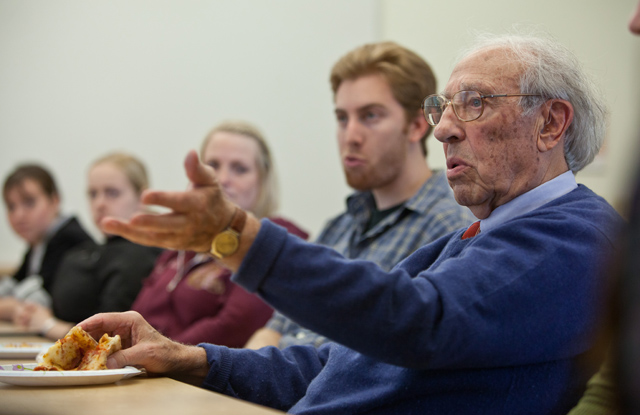Page 72 • (828 results in 0.187 seconds)
-
entries in the main Rieke hallway and vote on your favorite between Tuesday and Thursday. The winners will be revealed on the last day of Rieke Weekie. 1:45-2:45pm, Morken 203 Computer Science Tech Talk – “Best Practices in Software Development” with Andrew Grimberg, PLU ’98, Manager, Release Engineering at the Linux Foundation Wednesday, November 15th 10:30-11am, Rieke Lobby Natural Sciences opportunity event Visit with the Alumni & Student Connections staff to learn about finding internships
-
said. “It’s fun to do something that spreads what I know to a larger audience.” The Scandinavian Studies scholar provided expertise on the Norse Gods, as well as how they relate to the writing of J.R.R. Tolkien – the author of The Lord of the Rings. This summer he flew to New York to film the segments and was referred by PLU Associate Professor of classics Eric Nelson to producer Chris Cassel. Nelson appeared as an expert in Cassel’s Emmy Award winning program “Rome: Engineering an Empire.” Nelson
-
video using scraps of story lines from the Godfather and the Mario brothers to hold for “ransom” a favored stuffed toy of Matt’s called “toad.” Or something like that. These guys have a tendency to talk over each other in the telling the story, as they gathered last week for a mini-reunion of sorts on the PLU campus. They had so much fun making the film, when again, they should have been studying for their classics or engineering finals, they made a film – Demon Hunters (think Buffy meets Monte
-

. “And that’s exactly the way it should be.” Born in China, and then growing up and studying in Switzerland, Fischer came to the U.S. in the 1950s, when biochemistry was in its infancy. He noted wryly that money poured into the National Institute of Health, and his field of research, after then President Eisenhower had a heart attack. He marked the great technical advances of the 20th century squarely in the area of physics. As for the last half of the century – the fields of genetic engineering and
-

of the Culturally Sustaining STEM Teacher Program at Pacific Lutheran University helped prepare her for.Funded by a $1.2 million grant from the National Science Foundation, PLU’s Culturally Sustaining STEM Teacher Program provides funding for students earning their Master of Education (MAE) at PLU that plan to teach STEM (science, technology, engineering, and math) subjects at the middle or high school level. Scholarship recipients — like Anderson — attend monthly meetings to learn about equity
-

Scholarship grant from the National Science Foundation, the project seeks to encourage talented STEM (Science, Technology, Engineering and Mathematics) majors to become K-12 mathematics and science teachers. There’s a national shortage of these educators, especially in schools with high-needs student populations. PLU students Jimmy Aung and Jamie EscobarLeading a science class at Four Heroes Elementary as they explore the education through a grant funded program. PLU students Jimmy Aung and Jamie
-

provide significant scholarship support for low-income students in STEM, but it will also allow us to better integrate PLU resources and build new structures to support these students’ success.” The grant, funded by the NSF Scholarships in Science, Technology, Engineering, and Mathematics (S-STEM) program, will be awarded over a five-year period. It will provide scholarships and enhanced support for students who meet the criteria for federal Pell grants, with a particular focus on transfer and
-
Natural Sciences Poster Session (Morken Atrium)3:45 pm - Keynote Speaker (Morken 103):The Chemistry of Interfaces: Engineering Materials for Biotechnology, Aerospace and Beyond Dr. Kjersta Larson-Smith (PLU Alumna, 2006), Boeing Research and Technology, The Boeing Company The chemical interactions that occur at interfaces are often challenging to understand, yet they are critical to the engineering of new materials. This talk will explore the role of interfacial science for two vastly different
-
prevent cylinders from being knocked over or damaged. 1.2 Placing Cylinders Cylinders must be kept far enough away from the actual welding or cutting operation so that sparks, hot slag, or flame will not reach them. When this is impractical, fire resistant shields must be used. Cylinders must be placed where they cannot become part of an electrical circuit. Electrodes must not be struck against a cylinder to strike an arc. Fuel gas cylinders must be placed with valve end up whenever they are in use
-
never less than 10 feet (3.1 m). Exemption: Scaffolds and conductive materials handled on scaffolds may be closer to power lines than the minimum separation distance specified in Table 2 if all of the following are met: Less clearance is necessary to do the work The utility company or electrical system operator has been notified of the need to work closer to the power lines The utility company or electrical system operator has done at least one of the following: De-energized the lines Relocated the
Do you have any feedback for us? If so, feel free to use our Feedback Form.


